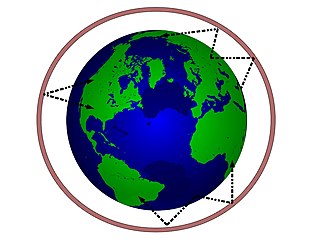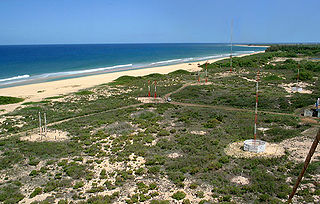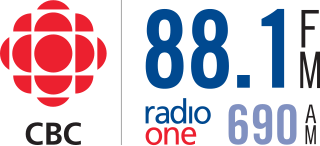Related Research Articles

Shortwave radio is radio transmission using radio frequencies in the shortwave bands (SW). There is no official definition of the band range, but it always includes all of the high frequency band (HF), which extends from 3 to 30 MHz ; above the medium frequency band (MF), to the bottom of the VHF band.
International broadcasting, in a limited extent, began during World War I, when German and British stations broadcast press communiqués using Morse code. With the severing of Germany's undersea cables, the wireless telegraph station in Nauen was the country's sole means of long-distance communication.

A radio clock or radio-controlled clock (RCC), and often colloquially referred to as an "atomic clock", is a type of quartz clock or watch that is automatically synchronized to a time code transmitted by a radio transmitter connected to a time standard such as an atomic clock. Such a clock may be synchronized to the time sent by a single transmitter, such as many national or regional time transmitters, or may use the multiple transmitters used by satellite navigation systems such as Global Positioning System. Such systems may be used to automatically set clocks or for any purpose where accurate time is needed. Radio clocks may include any feature available for a clock, such as alarm function, display of ambient temperature and humidity, broadcast radio reception, etc.

In radio, longwave, long wave or long-wave, and commonly abbreviated LW, refers to parts of the radio spectrum with wavelengths longer than what was originally called the medium-wave broadcasting band. The term is historic, dating from the early 20th century, when the radio spectrum was considered to consist of longwave (LW), medium-wave (MW), and short-wave (SW) radio bands. Most modern radio systems and devices use wavelengths which would then have been considered 'ultra-short'.

In radio communication, skywave or skip refers to the propagation of radio waves reflected or refracted back toward Earth from the ionosphere, an electrically charged layer of the upper atmosphere. Since it is not limited by the curvature of the Earth, skywave propagation can be used to communicate beyond the horizon, at intercontinental distances. It is mostly used in the shortwave frequency bands.
CHU is the call sign of a shortwave time signal radio station operated by the Institute for National Measurement Standards of the National Research Council. CHU's signal is used for continuous dissemination of official Canadian government time signals, derived from atomic clocks.

WWV is a shortwave radio station, located near Fort Collins, Colorado. It has broadcast a continuous time signal since 1945, and implements United States government frequency standards, with transmitters operating on 2.5, 5, 10, 15, and 20 MHz. WWV is operated by the U.S. National Institute of Standards and Technology (NIST), under the oversight of its Time and Frequency Division, which is part of NIST's Physical Measurement Laboratory based in Gaithersburg, Maryland.

WWVH is the callsign of the U.S. National Institute of Standards and Technology's shortwave radio time signal station located at the Barking Sands Missile Range, in Kekaha, on the island of Kauai in the state of Hawaii.
JJY is the call sign of a low frequency time signal radio station located in Japan.

RTÉ Radio 1 is an Irish national radio station owned and operated by RTÉ and is the direct descendant of Dublin radio station 2RN, which began broadcasting on a regular basis on 1 January 1926.

ABC Radio Melbourne is an ABC Local Radio station in Melbourne, Australia. It began transmission on 13 October 1924, and was Melbourne's second licensed radio station after 3AR.

Shortwave listening, or SWLing, is the hobby of listening to shortwave radio broadcasts located on frequencies between 1700 kHz and 30 MHz. Listeners range from casual users seeking international news and entertainment programming, to hobbyists immersed in the technical aspects of radio reception and collecting official confirmations that document their reception of distant broadcasts (DXing). In some developing countries, shortwave listening enables remote communities to obtain regional programming traditionally provided by local medium wave AM broadcasters. In 2002, the number of households that were capable of shortwave listening was estimated to be in the hundreds of millions.
HCJB, "The Voice of the Andes", was the first radio station with daily programming in Ecuador and the first Christian missionary radio station in the world. The station was founded in 1931 by Clarence W. Jones, Reuben Larson, and D. Stuart Clark. HCJB now focuses on Ecuador with unified programming on FM at 89.3 MHz in Pichincha, at 92.5 MHz in Manabí, at 96.1 MHz in Tungurahua and Cotopaxi, at 98.3 MHz in Esmeraldas and with separate programming on AM at 690 kHz. Broadcasts in Spanish and indigenous languages on 6.05 MHz (1 kW), continue on an intermittent basis with a new solid state transmitter which in 2017 replaced an older (5 kW) transmitter. These broadcasts were not listed on the HCJB English website as of February 2016.

ABC Radio Perth is the on-air identifier of a radio station located in Perth, Western Australia, operated by the Australian Broadcasting Corporation, and broadcasting at 720 kHz AM. It is the flagship ABC Local Radio station in Western Australia. The station was established under the Sealed Set scheme by Westralian Farmers in 1924, sold to the Commonwealth Government in 1928 and provided with programmes by the Australian Broadcasting Company, became part of the Australian Broadcasting Commission in 1932, which became the Australian Broadcasting Corporation in 1983.

CBU is a Canadian non-commercial public radio station, in Vancouver, British Columbia. It carries the programming of the CBC Radio One network. The station broadcasts on 690 AM and on 88.1 FM as CBU-2-FM. CBU's newscasts and local shows are also heard on a chain of CBC stations around the Lower Mainland.

Radio Ukraine International, abbreviated RUI, is the official international broadcasting station of Ukraine, with foreign language news and programming being produced by Ukrainian Radio's main editorial department for broadcasting in EBU languages. RUI broadcasts in Belarusian, Bulgarian, English, German, Hungarian, Polish, Romanian and Slovak. The Ukrainian language programming aired on RUI is produced by the domestic First Channel.
BSF is the callsign of the time signal transmitter owned by the National Time and Frequency Standards Laboratory of the Ministry of Economic Affairs (Taiwan), which transmits time information on 77.5 kHz in the longwave range. It was launched on May 1, 1969 and is broadcast from Zhongli District in Taichung using a T-antenna located at 25°0′20″N121°21′54″E.
Broadcast call signs are call signs assigned as unique identifiers to radio stations and television stations. While broadcast radio stations will often brand themselves with plain-text names, identities such as "cool FM", "rock 105" or "the ABC network" are not globally unique. Another station in another city or country may have a similar brand, and the name of a broadcast station for legal purposes is normally its internationally recognised ITU call sign. Some common conventions are followed around the world.

A shortwave radio receiver is a radio receiver that can receive one or more shortwave bands, between 1.6 and 30 MHz. A shortwave radio receiver often receives other broadcast bands, such as FM radio, Longwave and Mediumwave. Shortwave radio receivers are often used by dedicated hobbyists called shortwave listeners.
References
- ↑ From QSL card confirming reception on 28 December 1974 in Seattle, Washington, USA on 12 MHz. Source: http://mesamike.org/radio/swl/qsl/VNG.html
- ↑ "1946 - VNG Time Signal Station".
- ↑ Klawitter, G. (1980). List of Time Signal Stations (9th ed.). Wuerzburg: Boehler-Verlag GmbH. pp. 11–12.
- ↑ Klingenfuss, J. (2001). 2002 Guide to Utility Radio Stations (20th ed.). Klingenfuss. pp. 54, 97, 162, 229, 274, 384. ISBN 3-924509-02-6.

